Criminology 101 Assignment: Review of Key Concepts and Theories
VerifiedAdded on 2022/07/28
|11
|1728
|14
Homework Assignment
AI Summary
This criminology assignment explores several key concepts and theories within the field. Part 1 provides short answer responses covering intimate partner fatality reviews, race and crime in Canada, white-collar crime, various models of sentencing (justice, rehabilitative, restorative), the harm reduction model, the Canadian justice system, the Gladue ruling, and police misconduct. Part 2 presents an essay on intersectionality, discussing how factors like race, gender, and class intersect to create systems of oppression, using examples like the overrepresentation of Aboriginal people in the Australian prison system and the disadvantages faced by minority women in domestic work. The assignment references O'Grady's (2007) 'Crime in Canadian Context' to support its arguments and provides an overview of key sociological explanations for crime, including Durkheim's theories on anomie and social change, Merton's strain theory, and the Chicago School's concept of social disorganization. It also touches upon critical criminologies, including discussions on race, crime, and intersectionality.
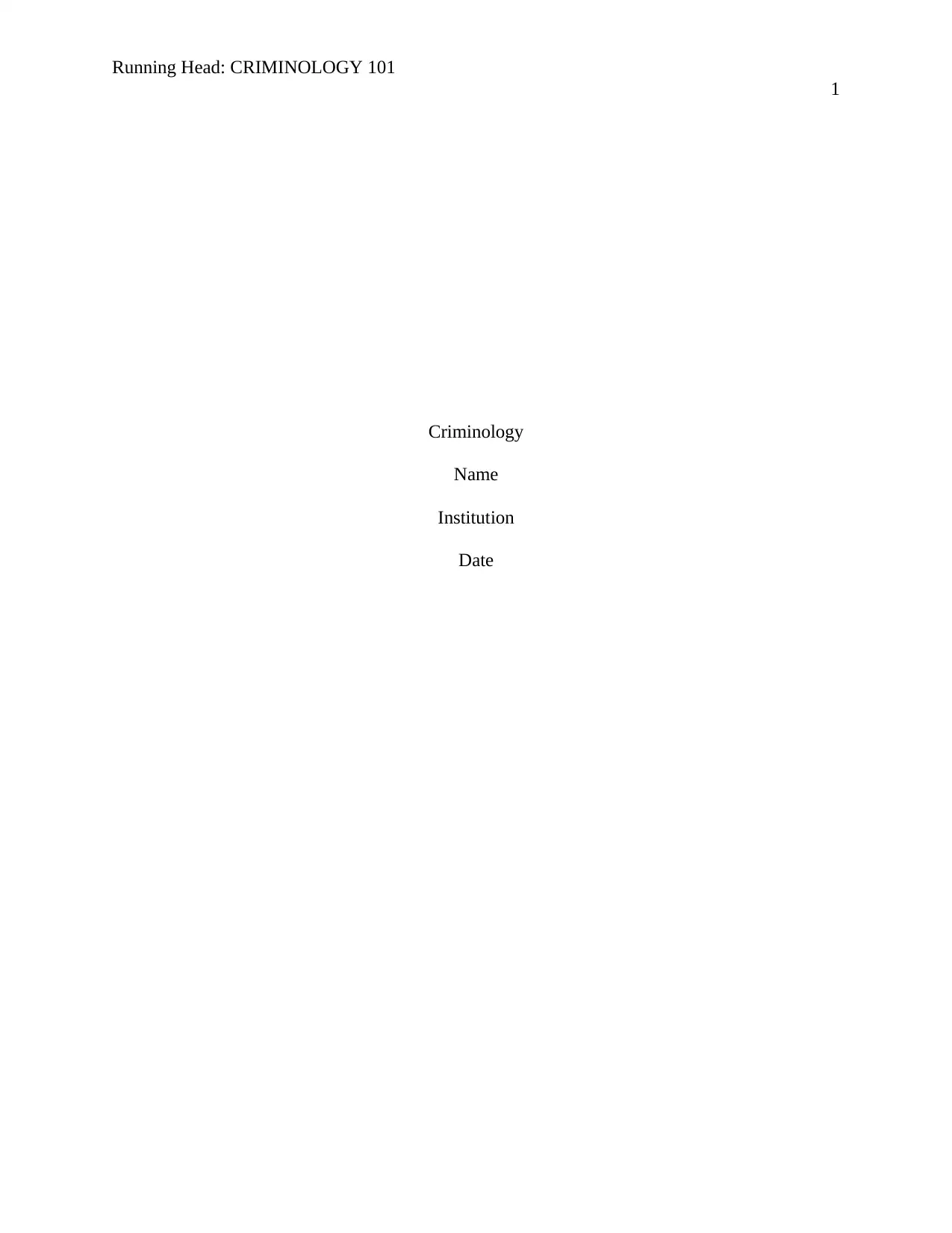
Running Head: CRIMINOLOGY 101
1
Criminology
Name
Institution
Date
1
Criminology
Name
Institution
Date
Paraphrase This Document
Need a fresh take? Get an instant paraphrase of this document with our AI Paraphraser
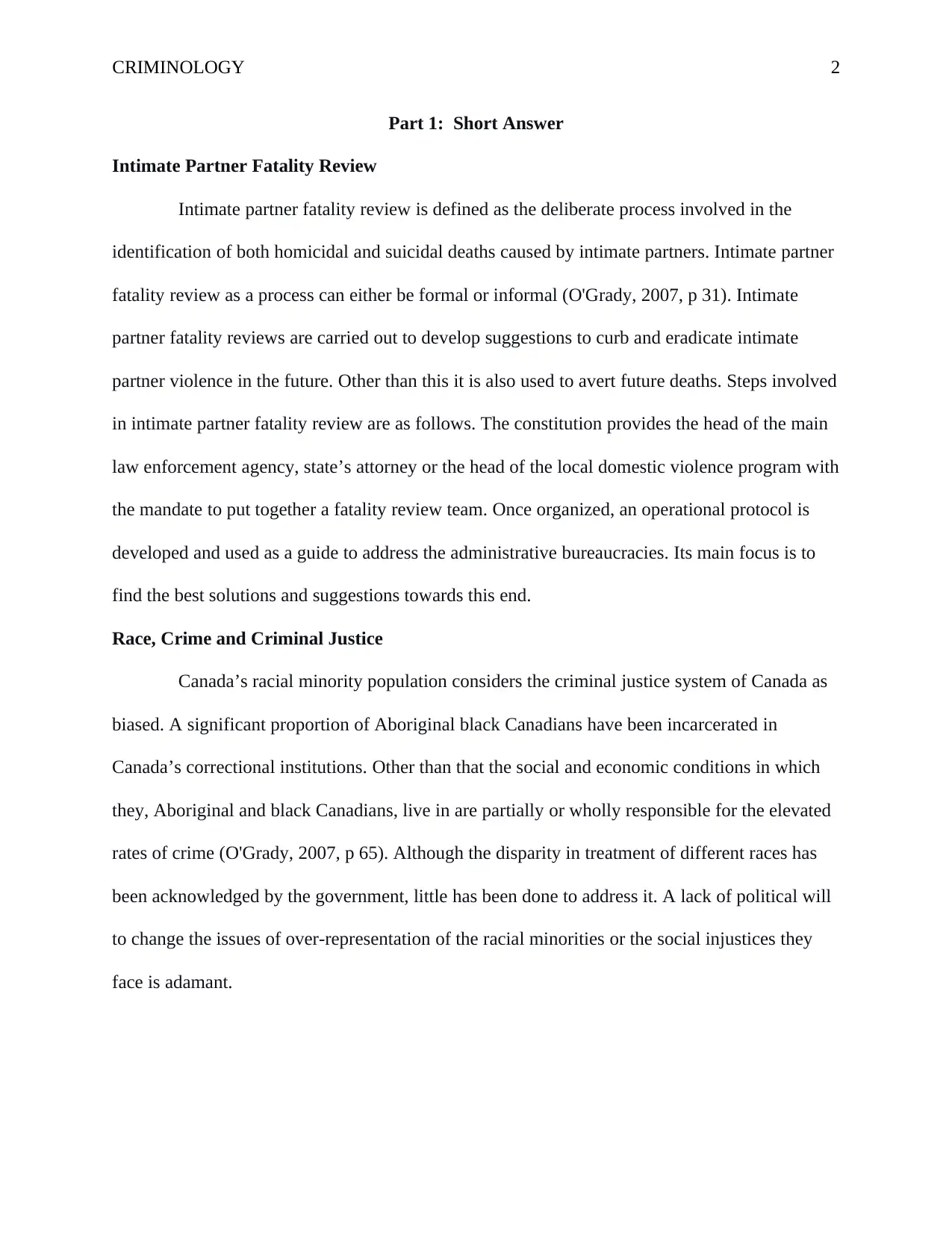
CRIMINOLOGY 2
Part 1: Short Answer
Intimate Partner Fatality Review
Intimate partner fatality review is defined as the deliberate process involved in the
identification of both homicidal and suicidal deaths caused by intimate partners. Intimate partner
fatality review as a process can either be formal or informal (O'Grady, 2007, p 31). Intimate
partner fatality reviews are carried out to develop suggestions to curb and eradicate intimate
partner violence in the future. Other than this it is also used to avert future deaths. Steps involved
in intimate partner fatality review are as follows. The constitution provides the head of the main
law enforcement agency, state’s attorney or the head of the local domestic violence program with
the mandate to put together a fatality review team. Once organized, an operational protocol is
developed and used as a guide to address the administrative bureaucracies. Its main focus is to
find the best solutions and suggestions towards this end.
Race, Crime and Criminal Justice
Canada’s racial minority population considers the criminal justice system of Canada as
biased. A significant proportion of Aboriginal black Canadians have been incarcerated in
Canada’s correctional institutions. Other than that the social and economic conditions in which
they, Aboriginal and black Canadians, live in are partially or wholly responsible for the elevated
rates of crime (O'Grady, 2007, p 65). Although the disparity in treatment of different races has
been acknowledged by the government, little has been done to address it. A lack of political will
to change the issues of over-representation of the racial minorities or the social injustices they
face is adamant.
Part 1: Short Answer
Intimate Partner Fatality Review
Intimate partner fatality review is defined as the deliberate process involved in the
identification of both homicidal and suicidal deaths caused by intimate partners. Intimate partner
fatality review as a process can either be formal or informal (O'Grady, 2007, p 31). Intimate
partner fatality reviews are carried out to develop suggestions to curb and eradicate intimate
partner violence in the future. Other than this it is also used to avert future deaths. Steps involved
in intimate partner fatality review are as follows. The constitution provides the head of the main
law enforcement agency, state’s attorney or the head of the local domestic violence program with
the mandate to put together a fatality review team. Once organized, an operational protocol is
developed and used as a guide to address the administrative bureaucracies. Its main focus is to
find the best solutions and suggestions towards this end.
Race, Crime and Criminal Justice
Canada’s racial minority population considers the criminal justice system of Canada as
biased. A significant proportion of Aboriginal black Canadians have been incarcerated in
Canada’s correctional institutions. Other than that the social and economic conditions in which
they, Aboriginal and black Canadians, live in are partially or wholly responsible for the elevated
rates of crime (O'Grady, 2007, p 65). Although the disparity in treatment of different races has
been acknowledged by the government, little has been done to address it. A lack of political will
to change the issues of over-representation of the racial minorities or the social injustices they
face is adamant.
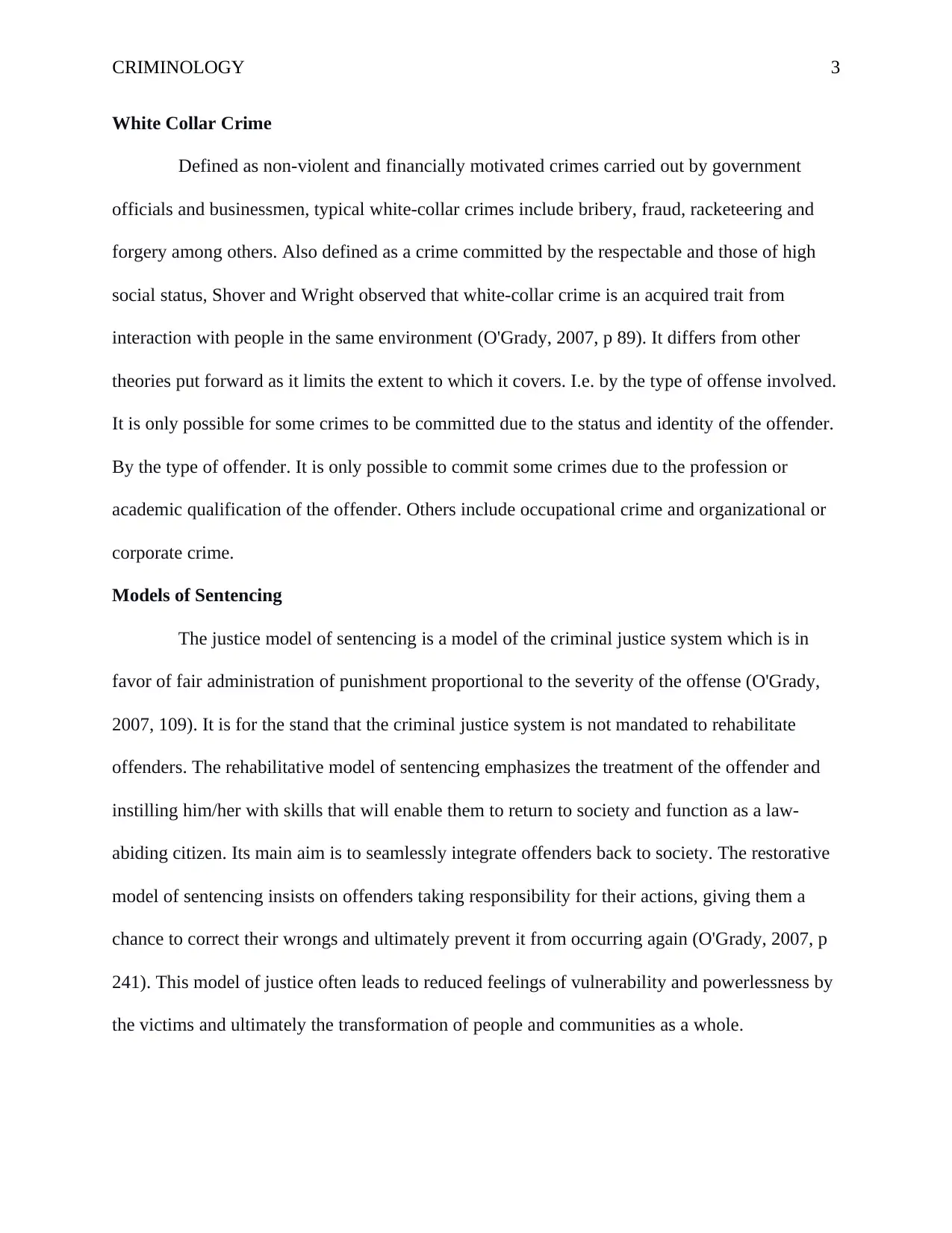
CRIMINOLOGY 3
White Collar Crime
Defined as non-violent and financially motivated crimes carried out by government
officials and businessmen, typical white-collar crimes include bribery, fraud, racketeering and
forgery among others. Also defined as a crime committed by the respectable and those of high
social status, Shover and Wright observed that white-collar crime is an acquired trait from
interaction with people in the same environment (O'Grady, 2007, p 89). It differs from other
theories put forward as it limits the extent to which it covers. I.e. by the type of offense involved.
It is only possible for some crimes to be committed due to the status and identity of the offender.
By the type of offender. It is only possible to commit some crimes due to the profession or
academic qualification of the offender. Others include occupational crime and organizational or
corporate crime.
Models of Sentencing
The justice model of sentencing is a model of the criminal justice system which is in
favor of fair administration of punishment proportional to the severity of the offense (O'Grady,
2007, 109). It is for the stand that the criminal justice system is not mandated to rehabilitate
offenders. The rehabilitative model of sentencing emphasizes the treatment of the offender and
instilling him/her with skills that will enable them to return to society and function as a law-
abiding citizen. Its main aim is to seamlessly integrate offenders back to society. The restorative
model of sentencing insists on offenders taking responsibility for their actions, giving them a
chance to correct their wrongs and ultimately prevent it from occurring again (O'Grady, 2007, p
241). This model of justice often leads to reduced feelings of vulnerability and powerlessness by
the victims and ultimately the transformation of people and communities as a whole.
White Collar Crime
Defined as non-violent and financially motivated crimes carried out by government
officials and businessmen, typical white-collar crimes include bribery, fraud, racketeering and
forgery among others. Also defined as a crime committed by the respectable and those of high
social status, Shover and Wright observed that white-collar crime is an acquired trait from
interaction with people in the same environment (O'Grady, 2007, p 89). It differs from other
theories put forward as it limits the extent to which it covers. I.e. by the type of offense involved.
It is only possible for some crimes to be committed due to the status and identity of the offender.
By the type of offender. It is only possible to commit some crimes due to the profession or
academic qualification of the offender. Others include occupational crime and organizational or
corporate crime.
Models of Sentencing
The justice model of sentencing is a model of the criminal justice system which is in
favor of fair administration of punishment proportional to the severity of the offense (O'Grady,
2007, 109). It is for the stand that the criminal justice system is not mandated to rehabilitate
offenders. The rehabilitative model of sentencing emphasizes the treatment of the offender and
instilling him/her with skills that will enable them to return to society and function as a law-
abiding citizen. Its main aim is to seamlessly integrate offenders back to society. The restorative
model of sentencing insists on offenders taking responsibility for their actions, giving them a
chance to correct their wrongs and ultimately prevent it from occurring again (O'Grady, 2007, p
241). This model of justice often leads to reduced feelings of vulnerability and powerlessness by
the victims and ultimately the transformation of people and communities as a whole.
⊘ This is a preview!⊘
Do you want full access?
Subscribe today to unlock all pages.

Trusted by 1+ million students worldwide
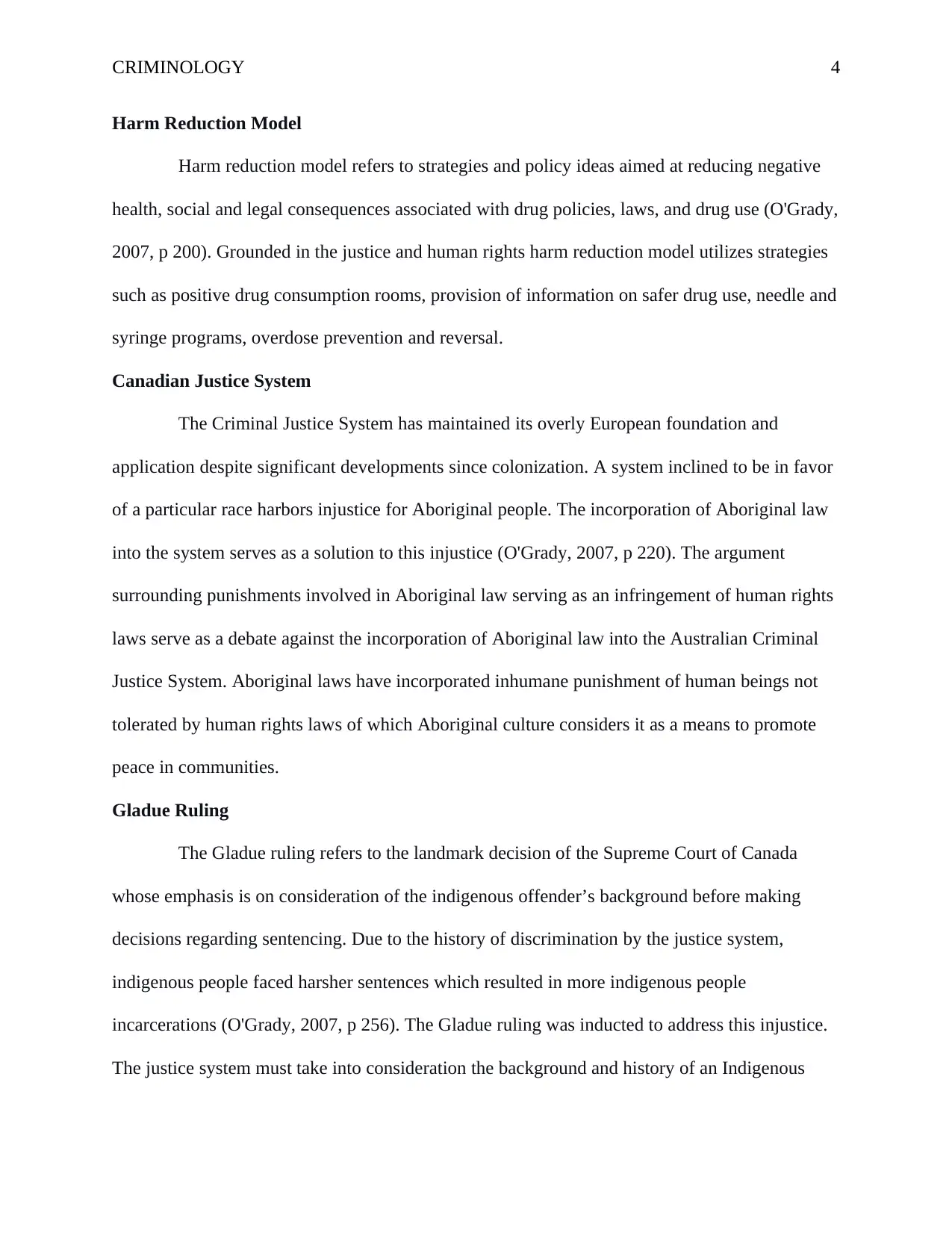
CRIMINOLOGY 4
Harm Reduction Model
Harm reduction model refers to strategies and policy ideas aimed at reducing negative
health, social and legal consequences associated with drug policies, laws, and drug use (O'Grady,
2007, p 200). Grounded in the justice and human rights harm reduction model utilizes strategies
such as positive drug consumption rooms, provision of information on safer drug use, needle and
syringe programs, overdose prevention and reversal.
Canadian Justice System
The Criminal Justice System has maintained its overly European foundation and
application despite significant developments since colonization. A system inclined to be in favor
of a particular race harbors injustice for Aboriginal people. The incorporation of Aboriginal law
into the system serves as a solution to this injustice (O'Grady, 2007, p 220). The argument
surrounding punishments involved in Aboriginal law serving as an infringement of human rights
laws serve as a debate against the incorporation of Aboriginal law into the Australian Criminal
Justice System. Aboriginal laws have incorporated inhumane punishment of human beings not
tolerated by human rights laws of which Aboriginal culture considers it as a means to promote
peace in communities.
Gladue Ruling
The Gladue ruling refers to the landmark decision of the Supreme Court of Canada
whose emphasis is on consideration of the indigenous offender’s background before making
decisions regarding sentencing. Due to the history of discrimination by the justice system,
indigenous people faced harsher sentences which resulted in more indigenous people
incarcerations (O'Grady, 2007, p 256). The Gladue ruling was inducted to address this injustice.
The justice system must take into consideration the background and history of an Indigenous
Harm Reduction Model
Harm reduction model refers to strategies and policy ideas aimed at reducing negative
health, social and legal consequences associated with drug policies, laws, and drug use (O'Grady,
2007, p 200). Grounded in the justice and human rights harm reduction model utilizes strategies
such as positive drug consumption rooms, provision of information on safer drug use, needle and
syringe programs, overdose prevention and reversal.
Canadian Justice System
The Criminal Justice System has maintained its overly European foundation and
application despite significant developments since colonization. A system inclined to be in favor
of a particular race harbors injustice for Aboriginal people. The incorporation of Aboriginal law
into the system serves as a solution to this injustice (O'Grady, 2007, p 220). The argument
surrounding punishments involved in Aboriginal law serving as an infringement of human rights
laws serve as a debate against the incorporation of Aboriginal law into the Australian Criminal
Justice System. Aboriginal laws have incorporated inhumane punishment of human beings not
tolerated by human rights laws of which Aboriginal culture considers it as a means to promote
peace in communities.
Gladue Ruling
The Gladue ruling refers to the landmark decision of the Supreme Court of Canada
whose emphasis is on consideration of the indigenous offender’s background before making
decisions regarding sentencing. Due to the history of discrimination by the justice system,
indigenous people faced harsher sentences which resulted in more indigenous people
incarcerations (O'Grady, 2007, p 256). The Gladue ruling was inducted to address this injustice.
The justice system must take into consideration the background and history of an Indigenous
Paraphrase This Document
Need a fresh take? Get an instant paraphrase of this document with our AI Paraphraser

CRIMINOLOGY 5
accused person when deciding on a sentence with jail being a last resort. When a jail sentence is
given, Gladue principles are used in deciding the length of the sentence and other punishments.
Police Misconduct
Police officers have been given authority over the citizens they protect. When misused,
this authority can limit the liberty of citizens. Efforts have been made to balance, the need for
protection of citizens against the deprivation of their liberty (O'Grady, 2007). Police officers use
this to defend themselves when engaging in the unlawful arrest of citizens. The police force has
the power to utilize discretion. It is unclear though the reason as to why discretion varies from
police officer to another.
Part 2: Essay question
Intersectionality
Intersectionality refers to the theory that human beings are limited by several sources of
opposition. It involves the study of the manner in which race, disability, class, gender, sexuality
among others are factors that influence and produce changing relations of oppression and power.
It considers different people’s experiences and identities in an aim to perceive the discrimination
and oppression they face. There’s a profound documented overrepresentation of Aboriginal
people in the Australian prison system. Torres Strait Islander women stand for about around 3
percent of the overall female gender population in Australia. They account for 34.3 percent of all
incarcerated women in Australia. (O'Grady, 2007, p 301). In comparison, almost all economic
and social indicators including status, wages and job security, Black women, Latinas and Asian-
American women rank bottom below white women and ethnic minority males. In the field of
domestic work, vices such as gender, ethnicity and citizenship prove as profound disadvantages
to poor minority immigrant women.
accused person when deciding on a sentence with jail being a last resort. When a jail sentence is
given, Gladue principles are used in deciding the length of the sentence and other punishments.
Police Misconduct
Police officers have been given authority over the citizens they protect. When misused,
this authority can limit the liberty of citizens. Efforts have been made to balance, the need for
protection of citizens against the deprivation of their liberty (O'Grady, 2007). Police officers use
this to defend themselves when engaging in the unlawful arrest of citizens. The police force has
the power to utilize discretion. It is unclear though the reason as to why discretion varies from
police officer to another.
Part 2: Essay question
Intersectionality
Intersectionality refers to the theory that human beings are limited by several sources of
opposition. It involves the study of the manner in which race, disability, class, gender, sexuality
among others are factors that influence and produce changing relations of oppression and power.
It considers different people’s experiences and identities in an aim to perceive the discrimination
and oppression they face. There’s a profound documented overrepresentation of Aboriginal
people in the Australian prison system. Torres Strait Islander women stand for about around 3
percent of the overall female gender population in Australia. They account for 34.3 percent of all
incarcerated women in Australia. (O'Grady, 2007, p 301). In comparison, almost all economic
and social indicators including status, wages and job security, Black women, Latinas and Asian-
American women rank bottom below white women and ethnic minority males. In the field of
domestic work, vices such as gender, ethnicity and citizenship prove as profound disadvantages
to poor minority immigrant women.
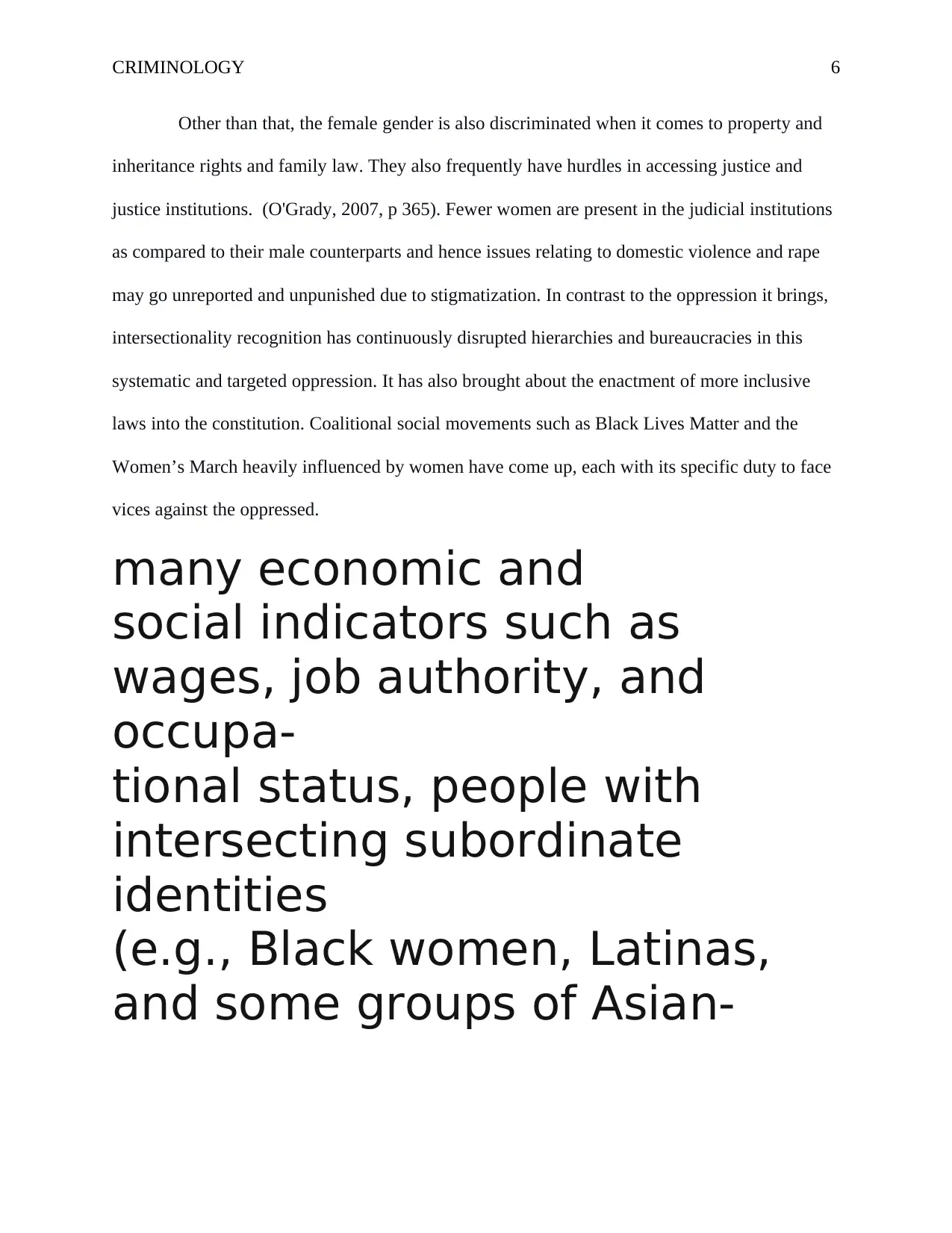
CRIMINOLOGY 6
Other than that, the female gender is also discriminated when it comes to property and
inheritance rights and family law. They also frequently have hurdles in accessing justice and
justice institutions. (O'Grady, 2007, p 365). Fewer women are present in the judicial institutions
as compared to their male counterparts and hence issues relating to domestic violence and rape
may go unreported and unpunished due to stigmatization. In contrast to the oppression it brings,
intersectionality recognition has continuously disrupted hierarchies and bureaucracies in this
systematic and targeted oppression. It has also brought about the enactment of more inclusive
laws into the constitution. Coalitional social movements such as Black Lives Matter and the
Women’s March heavily influenced by women have come up, each with its specific duty to face
vices against the oppressed.
many economic and
social indicators such as
wages, job authority, and
occupa-
tional status, people with
intersecting subordinate
identities
(e.g., Black women, Latinas,
and some groups of Asian-
Other than that, the female gender is also discriminated when it comes to property and
inheritance rights and family law. They also frequently have hurdles in accessing justice and
justice institutions. (O'Grady, 2007, p 365). Fewer women are present in the judicial institutions
as compared to their male counterparts and hence issues relating to domestic violence and rape
may go unreported and unpunished due to stigmatization. In contrast to the oppression it brings,
intersectionality recognition has continuously disrupted hierarchies and bureaucracies in this
systematic and targeted oppression. It has also brought about the enactment of more inclusive
laws into the constitution. Coalitional social movements such as Black Lives Matter and the
Women’s March heavily influenced by women have come up, each with its specific duty to face
vices against the oppressed.
many economic and
social indicators such as
wages, job authority, and
occupa-
tional status, people with
intersecting subordinate
identities
(e.g., Black women, Latinas,
and some groups of Asian-
⊘ This is a preview!⊘
Do you want full access?
Subscribe today to unlock all pages.

Trusted by 1+ million students worldwide
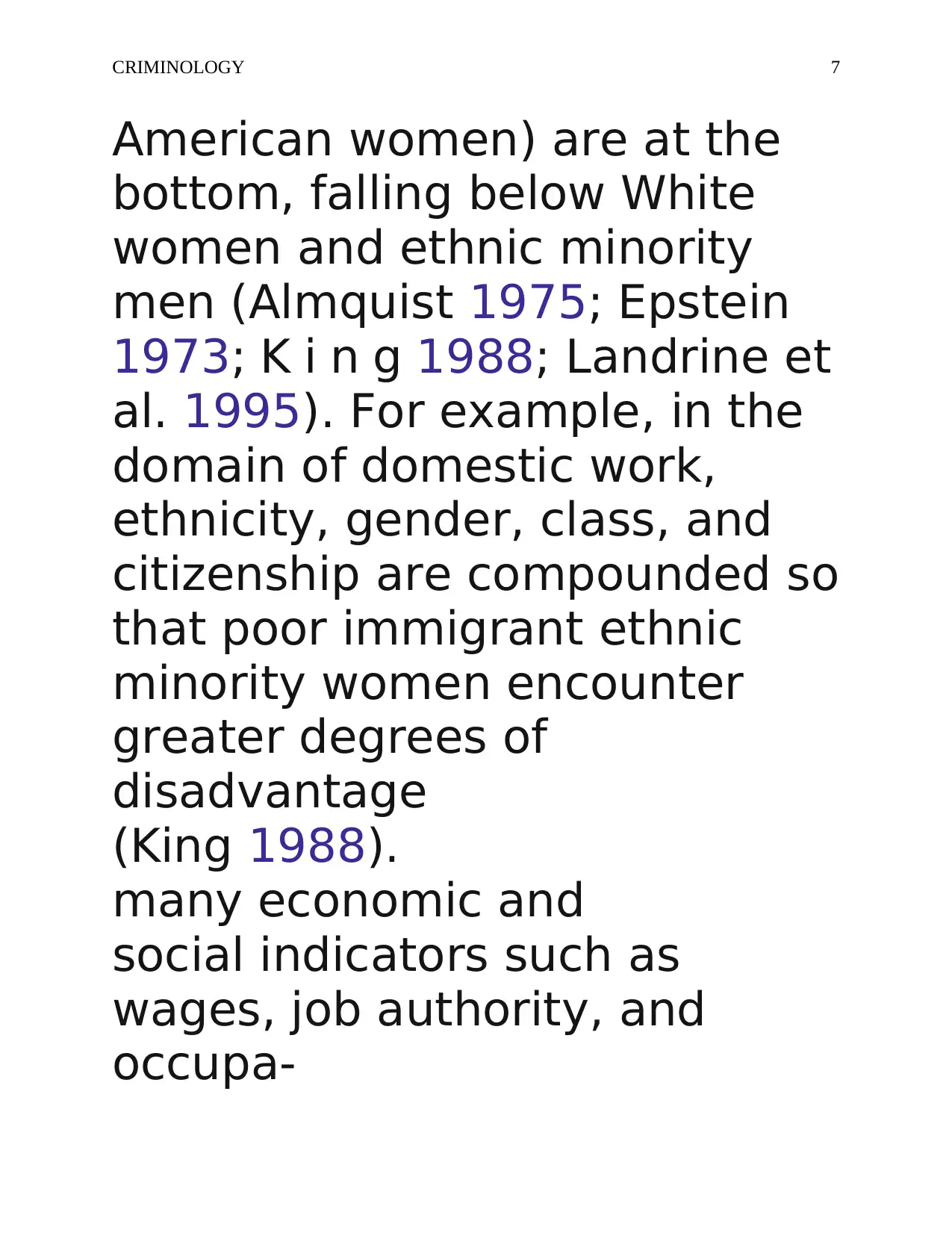
CRIMINOLOGY 7
American women) are at the
bottom, falling below White
women and ethnic minority
men (Almquist 1975; Epstein
1973; K i n g 1988; Landrine et
al. 1995). For example, in the
domain of domestic work,
ethnicity, gender, class, and
citizenship are compounded so
that poor immigrant ethnic
minority women encounter
greater degrees of
disadvantage
(King 1988).
many economic and
social indicators such as
wages, job authority, and
occupa-
American women) are at the
bottom, falling below White
women and ethnic minority
men (Almquist 1975; Epstein
1973; K i n g 1988; Landrine et
al. 1995). For example, in the
domain of domestic work,
ethnicity, gender, class, and
citizenship are compounded so
that poor immigrant ethnic
minority women encounter
greater degrees of
disadvantage
(King 1988).
many economic and
social indicators such as
wages, job authority, and
occupa-
Paraphrase This Document
Need a fresh take? Get an instant paraphrase of this document with our AI Paraphraser
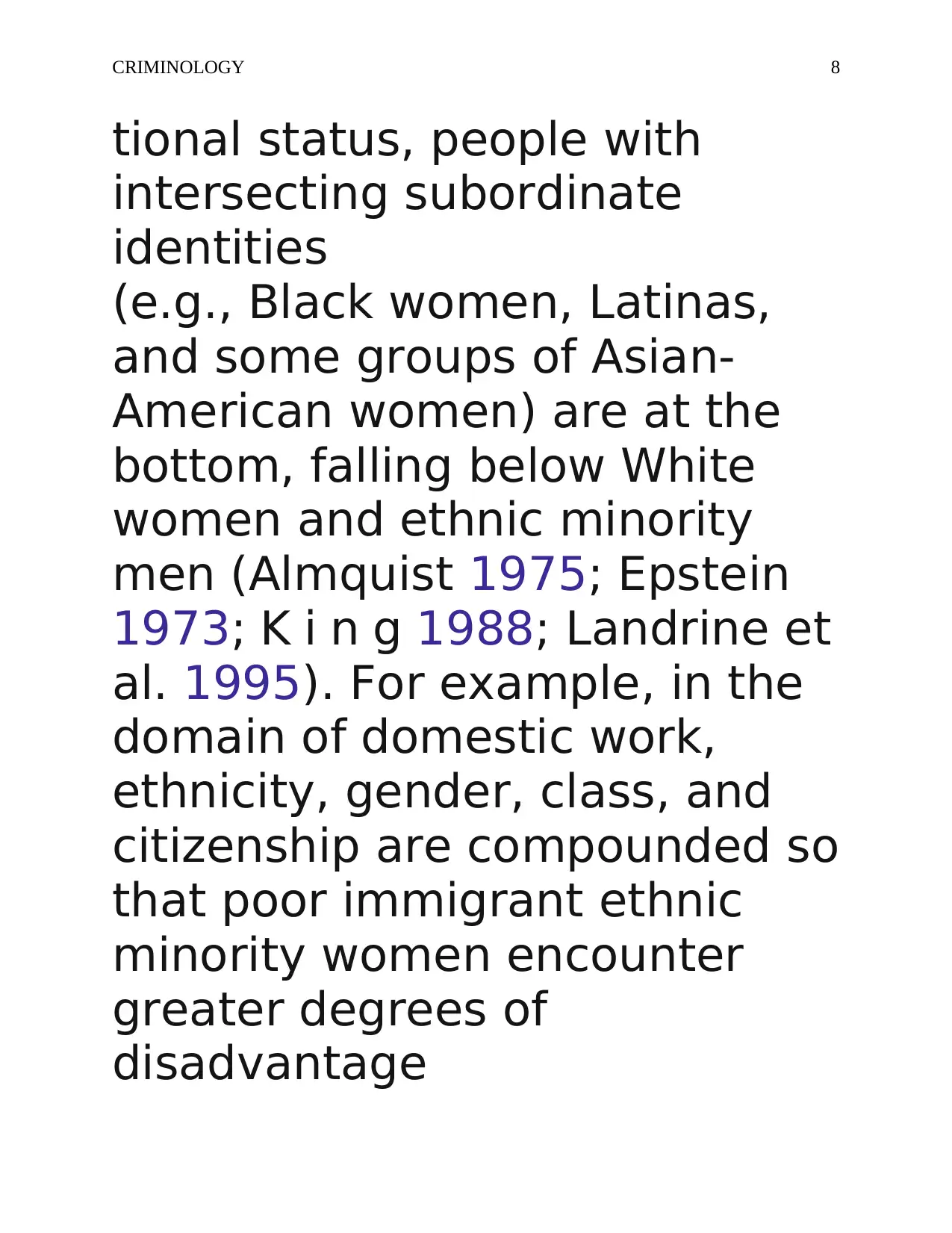
CRIMINOLOGY 8
tional status, people with
intersecting subordinate
identities
(e.g., Black women, Latinas,
and some groups of Asian-
American women) are at the
bottom, falling below White
women and ethnic minority
men (Almquist 1975; Epstein
1973; K i n g 1988; Landrine et
al. 1995). For example, in the
domain of domestic work,
ethnicity, gender, class, and
citizenship are compounded so
that poor immigrant ethnic
minority women encounter
greater degrees of
disadvantage
tional status, people with
intersecting subordinate
identities
(e.g., Black women, Latinas,
and some groups of Asian-
American women) are at the
bottom, falling below White
women and ethnic minority
men (Almquist 1975; Epstein
1973; K i n g 1988; Landrine et
al. 1995). For example, in the
domain of domestic work,
ethnicity, gender, class, and
citizenship are compounded so
that poor immigrant ethnic
minority women encounter
greater degrees of
disadvantage
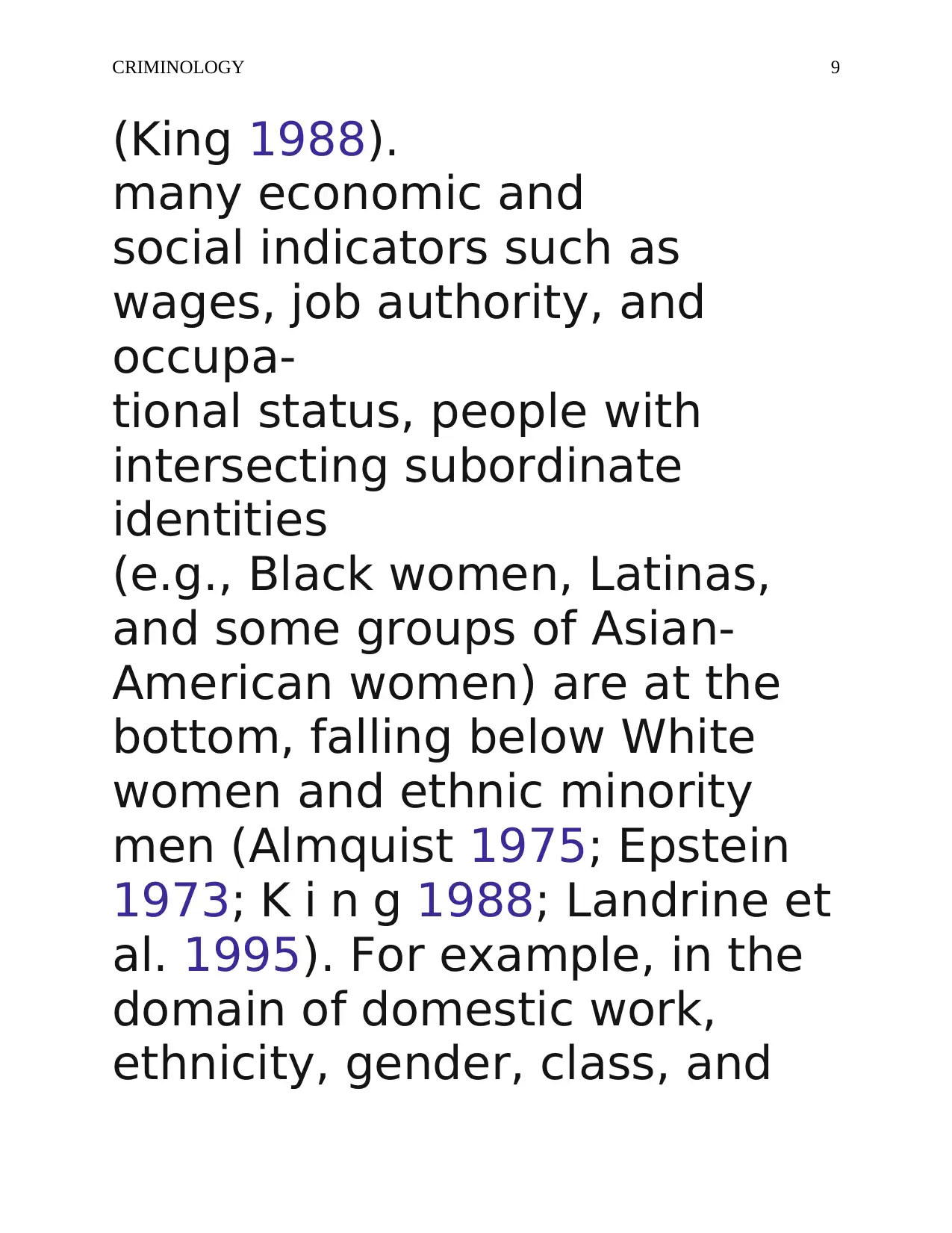
CRIMINOLOGY 9
(King 1988).
many economic and
social indicators such as
wages, job authority, and
occupa-
tional status, people with
intersecting subordinate
identities
(e.g., Black women, Latinas,
and some groups of Asian-
American women) are at the
bottom, falling below White
women and ethnic minority
men (Almquist 1975; Epstein
1973; K i n g 1988; Landrine et
al. 1995). For example, in the
domain of domestic work,
ethnicity, gender, class, and
(King 1988).
many economic and
social indicators such as
wages, job authority, and
occupa-
tional status, people with
intersecting subordinate
identities
(e.g., Black women, Latinas,
and some groups of Asian-
American women) are at the
bottom, falling below White
women and ethnic minority
men (Almquist 1975; Epstein
1973; K i n g 1988; Landrine et
al. 1995). For example, in the
domain of domestic work,
ethnicity, gender, class, and
⊘ This is a preview!⊘
Do you want full access?
Subscribe today to unlock all pages.

Trusted by 1+ million students worldwide
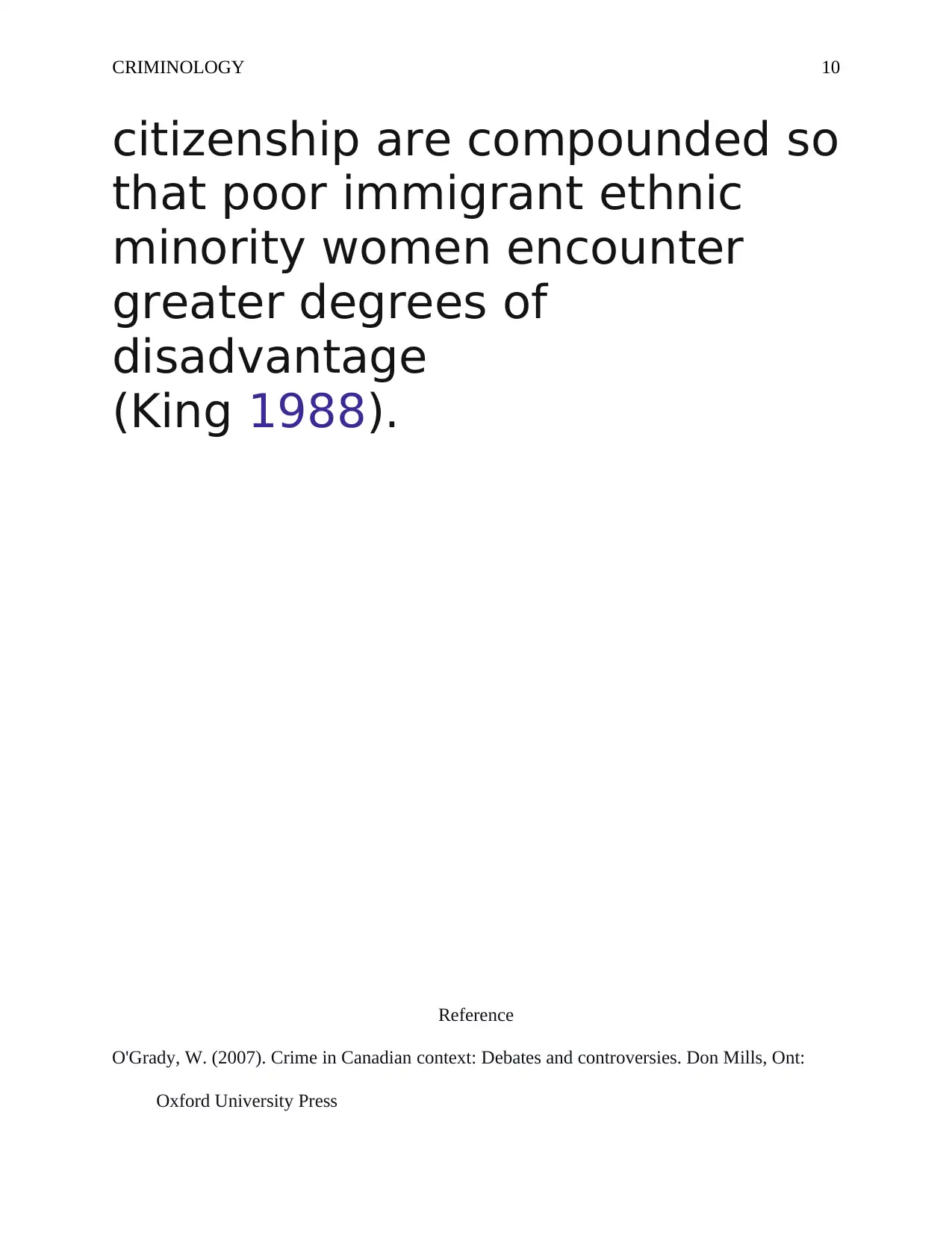
CRIMINOLOGY 10
citizenship are compounded so
that poor immigrant ethnic
minority women encounter
greater degrees of
disadvantage
(King 1988).
Reference
O'Grady, W. (2007). Crime in Canadian context: Debates and controversies. Don Mills, Ont:
Oxford University Press
citizenship are compounded so
that poor immigrant ethnic
minority women encounter
greater degrees of
disadvantage
(King 1988).
Reference
O'Grady, W. (2007). Crime in Canadian context: Debates and controversies. Don Mills, Ont:
Oxford University Press
Paraphrase This Document
Need a fresh take? Get an instant paraphrase of this document with our AI Paraphraser

CRIMINOLOGY 11
1 out of 11
Your All-in-One AI-Powered Toolkit for Academic Success.
+13062052269
info@desklib.com
Available 24*7 on WhatsApp / Email
![[object Object]](/_next/static/media/star-bottom.7253800d.svg)
Unlock your academic potential
Copyright © 2020–2025 A2Z Services. All Rights Reserved. Developed and managed by ZUCOL.